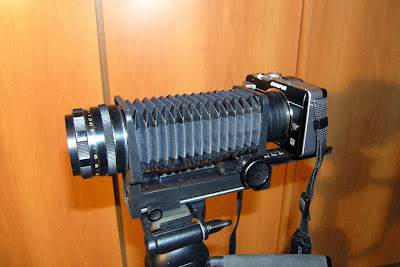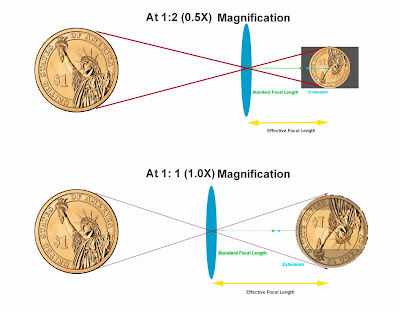 |
| Photo by: Kirill Ignatyev |
What does f number mean?
The f number is a measure of the amount of light the lens passes on to the sensor.
What does focal length mean?
The focal length engraved on the lens barrel is a measurement taken when the lens is focused at infinity (∞ position). They are calculated using the following equation.
F number = focal length of the lens (at ∞ position) / working diameter of the lens aperture.
So when we say f/4 for a 50mm lens; we are referring to a certain amount of light passing through a hole which is 12.5mm.
4=50/? Which translates to ?=50/4 and that is 12.5mm.
So focal length at infinity divided by working diameter is the f number; "f" is thus an abbreviation for "focal ratio".
Now it’s time for us to look at what happens when we attempt to focus the lens at even closer distances than normally possible. As we bring the focus point closer and closer; the lens need to be moved further and further away from the sensor. This movement of lens is called extension, to achieve low magnification the lens only need to move a tiny bit and the lens always stays at the expected distance which will be roughly one focal length from the sensor.
However when we try to attain even greater magnifications, from 0.25x onwards, the lens would have moved so far away from its original position that it starts to behave like a lens of longer focal length. It its estimated that at life size or 1:1 magnification the lens would have moved twice the focal length from the camera’s sensor.
 |
| Lens Extension and Effective F Stop |
So let us know discuss what happens to our earlier equation when the focusing distances change.
F number = focal length of the lens (at ∞ position)/ working diameter of the lens aperture.
We know that the focal length has now doubled and its now 100mm instead of the earlier 50mm. diameter of the lens aperture remains the same at 12.5mm so to find out the effective f number.
?=100/12.5 = 8 thus we now have an effective aperture of f/8 which is 2 stops higher than the earlier f number. Thus our findings substantiate the general rule of thumb that at 1:1 the effective f-stop becomes about 2 stops greater than the value set using your camera.
Now the formula to estimate the effective f-stop at other magnifications:
Effective F-Stop = F-Stop x (1 + Magnification)
For example
When shooting at 0.5X magnification, then the effective f-stop for a lens set to f/4 will be somewhere between f/5.6 and f/6.3. (Effective f stop = 4 x (1 + 0.5) i.e 4 x 1.5 = 6)
The formula given above work pretty well for lenses near 50mm focal length. For longer lenses such as the 180mm you will need to know and factor in the pupil magnification of your lens into the formula given below to get accurate results.
Effective F-Stop = F-Stop x (1 + Magnification / Pupil Magnification)
Even this has its limitations first you need to know the pupil magnification of the lens to be used, things get even more complicated when we consider the fact that pupil magnification changes with focusing distance and it is rarely published by camera lens manufacturers.
So considering all this it is better to leave this at this, you need to know that the effective aperture will be different than what’s set on your camera when shooting at high magnifications. At 1:1 the effective f stop will be 2 stops higher than what’s set on the camera. Use the formula given to calculate effective f stop for any other magnifications (only remember results will be approximations and not exacts) and everything will be just fine.
What are the Consequences of Effective F stop increase?
Don’t be fooled by the expression “effective f stop”. For all practical purposes the lenses f stop has really changed and with this changes the depth of field, exposure time and the lenses susceptibility to diffraction. The depth of field will increase, so does the exposure time and the lens become more susceptible to diffraction (meaning the narrowest aperture you can use before diffraction sets is now a couple of stops wider). If earlier it was f/22 now it will be f/16 or f/11 depending upon the amount of magnification.
The viewfinder display would become darker due to low level of light coming through.
Some cameras lose the ability to autofocus with the minimum aperture goes beyond a certain f/stop.
If the F Stop actually increases then why is it called Effective F STOP?
The f stop does increase and as a result the amount of light getting into the sensor is reduced and you will need to increase your exposure time (either decrease shutter speed or increase ISO) to compensate for that.
A simple practical test to prove the point
- Attach a true macro lens to your camera (in this case a Canon 100mm f/2.8 IS USM Macro to a Canon 5d mkii).
- Set the camera on a tripod.
- Set shooting mode to aperture priority and set it to f/2.8
- Set the lens to infinity focus (set focus mode to manual on lens)
- Half press the shutter button to get a reading of shutter speed.
- Now turn the focus to reach the 1:2 magnification and press the shutter button half way to take a reading of shutter speed.
- Repeat the same with the lens set to the 1:1 magnification.
- You will notice that with everything else being the same (ISO, Aperture, Lighting conditions etc) the camera is suggesting slower and slower shutter speeds as the magnification increases. Also if you look through the viewfinder you will notice that it has also become darker (more like what you see when the lens is set to f/5.6 and the depth of field button is pressed). This is proof that the aperture has indeed changed but the camera is just showing the set aperture.
So the only the only reason why the word "effective" is used is because many cameras still show the uncompensated f-stop setting (as it would appear at low magnification).
With Nikon cameras it is the effective f/stop that is displayed and not the f/stop set on the lens, you could notice that without any input from your side the f/stop progressively increases as the focusing distance decreases. Even more proof.
.
When it comes to setting exposure variables, your camera's TTL (Through The Lens) meter will take into consideration the fall in light levels and will set the exposure so as to compensate that.